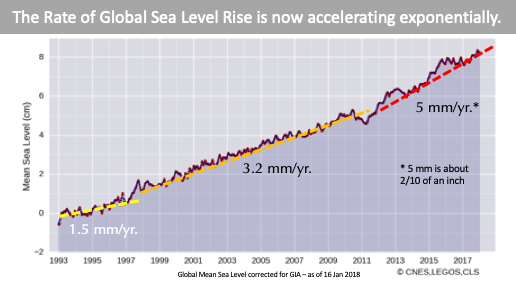How Long To Fill a Soccer Stadium with Water?

Two years ago I wrote a post “Beware The Doubling Time for Rising Seas.” It’s time for an update to that, which might be called “Behold the doubling time” because doubling the rate of ice melting and sea level rise has arrived sooner than I expected. “Doubling” or exponential growth is deceptive. It can mean wealth with an investment, or disaster with something like melting glaciers and rising sea level. To show exponential growth, previously I have used the example of doubling a penny every day for a month, which would become five million dollars by day 30. Now, my favorite example is filling a soccer stadium with water. Guess the answer to this challenge question, to see the power of exponential growth.
Imagine if you start with one drop of water in a stadium, and double it every minute. So that means 2 drops in two minutes; 4 drops in three minutes, 8 in four minutes, etc. How long would it take to fill the stadium? After you have made your guess, you can check the answer at the bottom of this post, in square brackets.
The time period for the doubling is the key. Sea level rise “SLR” is happening faster and faster, largely due to the melting of glaciers on land, particularly in Greenland and in Antarctica. A few decades ago, the doubling time for SLR was more than forty years. When I wrote my post two years ago, the doubling time was less than twenty years. As we will see in a moment, the time period for doubling from 2012-18 is already down to 12 years. That acceleration and pattern represents exponential growth and is a problem that we have great difficulty to recognize.
As the planet gets warmer and warmer due to higher levels of greenhouse gases (CO2, etc. ) the glaciers and ice sheets on Greenland and Antarctica will melt faster and faster, raising sea level – shortening the doubling time. (In another post, I explain the reason the ice is melting at an exponential rate, causing the rate of sea level rise to do the same.) Over the last century, global average SLR was about 20 cm, or about eight inches, though there are significant variations by location, mostly due to vertical land movement. That 20 cm a century is the same as 2 millimeters (mm) a year. As shown in the chart below, the current rate of SLR, from 2012 to 2018, is about 5 mm a year, which is very close to 2/10 of an inch. That small amount seems trivial, but like a drip filling a bucket, can be deceiving. (Metric is better understood globally and easier mathematically, but we’ll convert it to feet/inches as well.)
The slope of the 3 dotted lines is slightly but significantly becoming steeper, strong corroboration to exponential growth, just as we expected. As noted on the graph in just 25 years, we can see the rate go from an annual average of 1.5 mm, to 3.2, and then 5 in the most recent short period of six years. [Clarification: the 5 mm figure used here is a round up; as of 2019, the actual number is just over 4.5 mm.) This pattern of doubling, in time periods that are getting shorter is exponential growth. While some might argue that we need to wait several decades to confirm the exponential growth, the physics are quite clear and make a case to start planning now.
Let’s follow the hypothetical case of it doubling every decade. With the continued doubling, in ten years the current 5 mm, would be a 10 mm a year, then 20, then 40, 80, then 160 mm, per year. That theoretical increase of 160 mm a year is more than six inches annually, which would mean five feet a decade – assuming the rate of rise leveled off at six inches a year. Take a moment to think about what that would mean to all coastal communities worldwide. To be clear, I am not saying that we will have five feet of sea level rise a decade this century.
Frankly, there is no way to know precisely the future acceleration rate of SLR, because of the uncertainty of how quickly the ice sheets will melt, which in large part depends on how warm the planet gets in the next half-century. In turn, that depends on our energy consumption, how we produce the energy (fossil fuels v renewables) and any efforts at “geo-engineering” to reduce the sunlight or remove carbon dioxide from the atmosphere (also on my list for a future blog post).
Though we find it hard to believe that sea level can be higher, the geologic record is quite clear. Fourteen thousand years ago, sea level rose some 65 feet in just four centuries – that’s an average of more than a foot and half (half meter) every decade. At the last warm spot in the ice age cycles, 122,000 years ago – sea level reached some twenty-five feet (7 meters) above the present day. Currently, we are warming hundreds of times faster than at any time in the last few million years.
It will be a huge challenge for the world to adapt to sea levels that are many feet or meters higher than the present. The longer we pretend, or hope for the fantasy that it will not happen, the less time we have to adapt our communities, economies…our civilization. Even if the world keeps the commitment to the 2015 Paris Climate Agreement, sea level is still going to rise — with only a modest slowing of the acceleration.
As smart as we humans may be, we have trouble with two concepts that are relevant here: One is to take seriously the concept that sea level can be more than ten feet (3 meters) above present, which will move most shorelines miles (kilometers) inland. The second is the challenge of exponential growth illustrated above by the time to theoretically fill a stadium with water. The late Harvard professor Albert Allen Bartlett is famously quoted to say:
“The greatest shortcoming of the human race is our inability to understand the exponential function.”
Because of the phenomenon of exponential growth, sea level is going to rise at a rate that will surprise everyone. The next 50 years will not be anything like the last 50. It is time to adapt and prepare for the future.
[Answer to question in the second paragraph: A stadium will be filled to the very top with water in approximately 47 minutes. Depending on the stadium size it could be one minute more or less.]

